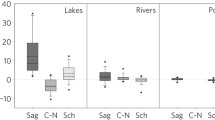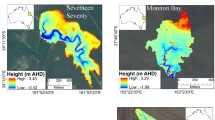Abstract
As reported from marine systems, we found that also in15 prealpine lakes N2O concentrations werestrongly correlated with O2 concentrations. Inoxic waters below the mixed surface layer, N2Oconcentrations usually increased with decreasingO2 concentrations. N2O is produced in oxicepilimnia, in oxic hypolimnia and at oxic-anoxicboundaries, either in the water or at the sediment-waterinterface. It is consumed, however, incompletely anoxic layers. Anoxic water layers weretherefore N2O undersaturated. All studied lakeswere sources for atmospheric N2O, including thosewith anoxic, N2O undersaturated hypolimnia.However, compared to agriculture, lakes seem not tocontribute significantly to atmospheric N2Oemissions.
Similar content being viewed by others
References
Bange HW, Rapsomanikis S & Andreae MO (1996) Nitrous oxide in coastal waters. Global Biogeochem. Cycles 10: 197–207
Betlach MR & Tiedje JM (1981) Kinetic explanation for accumulation of nitrite, nitric oxide and nitrous oxide during bacterial denitrification. Appl. Environ. Microbiol. 42: 1074–1084
Broecker WS & Peng TH (1982) Tracers in the Sea. Eldigio
Butler JH, Pequegnat JE, Gordon LI & Jones RD(1988) Cycling ofmethane, carbon monoxide, nitrous oxide, and hydroxylamine in a meromictic, coastal lagoon. Estuarine Coastal Shelf Sci. 27: 181–203
Butler JH, Elkins JW, Thompson TM & Egan KB (1989) Tropospheric and dissolved N2O of the West Pacific and East Indian Oceans during the El Nino Southern Oscillation event of 1987. J. Geophys. Res. 94: 14865–14877
Butler JH & Elkins JW(1991) An automated technique for the measurement of dissolved N2O in natural waters. Mar. Chem. 34: 47–61
Codispoti LA & Christensen JP (1985) Nitrification, denitrification and nitrous oxide cycling in the eastern tropical south pacific ocean. Mar. Chem. 16: 277–300
Codispoti LA, Elkins JW, Yoshinari T, Friederich GE, Sakamoto CM & Packard TT (1992) On the nitrous oxide flux from productive regions that contain low oxygen waters. In: Desai BN (Ed) Oceanography of the Indian Ocean (pp 271-284). Balkema
Cohen Y & Gordon LI (1979) Nitrous oxide production in the ocean. J. Geophys. Res. 84: 347–353
Downes MT (1988) Aquatic nitrogen transformations at low oxygen concentrations. Appl. Environ. Microbiol. 54: 172–175
Downes MT (1991) The production and consumption of nitrate in an eutrophic lake during early stratification. Arch. Hydrobiol. 122: 257–274
Elkins JW, Wofsy SC, McElroy MB, Kolb CE & Kaplan WA (1978) Aquatic sources and sinks for nitrous oxide. Nature 275: 602–606
Gächter R & Meyer JS (1990) Mechanisms controlling fluxes of nutrients across the sediment/ water interface in a eutrophic lake. In: Baudo R. et al. (Eds) Sediments: Chemistry and Toxicity of In-Place Pollutants (pp 131–162). Lewis
2and N2Oby nitrifying bacteria at reduced concentrations of oxygen}. Appl. Environ. Microbiol. 40: 526–532
Grud A & Fuhrer J (1995) Treibhausgasemissionen der schweizerischen Landwirtschaft. Agrarforschung 2: 217–220
Hahn J (1974) The north atlantic as a source of atmospheric N2O. Tellus 26: 160–168
IPCC (Intergovernmental Panel on Climate Change) (1990) Climate Change. Cambridge, pp. XXI and 25–26
Knowles R, Lean DRS & Chan YK (1981) Nitrous oxide concentrations in lakes: Variations with depth and time. Limnol. Oceanogr. 26: 855–866
Koike I & Terauchi K (1996) Fine scale distribution of nitrous oxide in marine sediments. Mar. Chem. 52: 185–193
Law CS & Owens NJP (1990) Significant flux of atmospheric nitrous oxide from the northwest Indian Ocean. Nature 346: 826–929
Law CS, Rees AP & Owens NJP (1992) Nitrous oxide: Estuarine sources and atmospheric flux. Estuarine Coastal Shelf Sci. 35: 301–314
Law CS, Rees AP & Owens NJP (1993) Nitrous oxide production by estuarine epiphyton. Limnol. Oceanogr. 38: 435–441
Lemon E & Lemon D (1981) Nitrous oxide in freshwaters of the Great Lakes Basin. Limnol. Oceanogr. 26: 867–879
Lerman A (1979) Geochemical Processes: Water and Sediment Environments. Wiley
Machida T, Nakazawa T, Fujii Y, Aoki S & Watanabe O (1995) Increase in the atmospheric nitrous oxide concentration during the last 250 years. Geophys. Res. Lett. 22: 2921–2924
Mengis M, Gächter R & Wehrli B (1996) Nitrous oxide emissions to the atmosphere from an artificially oxygenated lake. Limnol. Oceanogr. 41: 548–553
Naqvi SWA & Noronha RJ (1991) Nitrous oxide in the arabian sea. Deep-Sea Res. 38: 871–890
Nevison CD, Weiss RF & Erickson III DJ (1995) Global oceanic emissions of nitrous oxide. J. Geophys. Res. 100: 15809–15820
Nishio T, Koike I & Hattori A (1983) Estimates of denitrification and nitrification in coastal and estuarine sediments. Appl. Environ. Microbiol. 45: 444–450
Outdot C, Andrie C & Montel Y (1990) Nitrous oxide production in the tropical Atlantic Ocean. Deep-Sea Res. 37: 183–202
Rönner U (1983) Distribution, production and consumption of nitrous oxide in the Baltic Sea. Geochim. Cosmochim. Acta 47: 2179–2188
Schwarzenbach RP, Gschwend PM & Imboden DM(1993) Environmental Organic Chemistry. 1st edn. Wiley
Seitzinger SP (1988) Denitrification in freshwater and coastal marine ecosystems: Ecological and geochemical significance. Limnol. Oceanogr. 33: 702–724
2 to NH+ 4 and N2O by a soil Citrobacter sp}. Appl. Environ. Microbiol. 43: 854–860
VEB (1971) Ausgewählte Methoden der Wasseruntersuchung. Bd. 1, VEB Gustav Fischer Verlag, Jena (Germany)
Vincent WF, Downes MT & VincentCL (1981) Nitrous oxide cycling in LakeVanda,Antartica. Nature 292: 618–620
Weathers PJ (1984) N2O evolution by green algae. Appl. Env. Microbiol. 48: 1251–1253
Weiss RF & Price BA (1980) Nitrous oxide solubility in water and seawater. Mar. Chem. 8: 347–359
Wüest A & Gloor M (1995) Bottom boundary mixing in lakes: The role of the near-sediment density stratification. Proceedings of IUTAM-Symposium, Broome (Australia)
Wissmar RC, Lilley MD & deAngelis M (1987) Nitrous oxide release from aerobic riverine deposits. J. Freshwat. Ecol. 4: 209–218
Yoh M, Terai H & Saijo Y (1988) Nitrous oxide in freshwater lakes. Arch. Hydrobiol. 113: 273–294
Yoshinari T (1976) Nitrous oxide in the sea. Mar. Chem. 4: 189–202
Yoshinari T (1985) Nitrite and nitrous oxide production by Methylosinus trichosporium. Can. J. Microbiol. 31: 139–144
Author information
Authors and Affiliations
Rights and permissions
About this article
Cite this article
MENGIS, M., GÄCHTER, R. & WEHRLI, B. Sources and sinks of nitrous oxide (N2O) in deep lakes. Biogeochemistry 38, 281–301 (1997). https://doi.org/10.1023/A:1005814020322
Issue Date:
DOI: https://doi.org/10.1023/A:1005814020322




